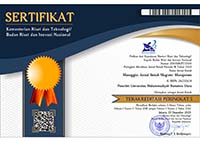Analysis of Oil Palm Production Efficiency in PTPN IV Gardens North Sumatra
Abstract
PT. Perkebunan Nusantara IV (PTPN IV) is palm oil plantation that has the highest productivity among the company's state-owned palm oil plantation in Sumatra. With the high productivity is owned by PTPN IV indicates the fact that PTPN IV has a level of efficiency that is also the highest. Therefore, the purpose of this research is to measure the efficiency of palm oil plantations in PTPN IV to analyze the level of efficiency of production in PTPN IV, knowing efficiency of PTPN IV based on the age of the plant and land suitability classes, and increasing the efficiency of palm oil plantations that are not efficient. To answer these objectives, this research uses data from a panel of 27 business units in the palm oil plantation of PTPN IV by the use of existing data envelopment analysis (DEA) model and a different test.
The results showed, palm oil plantations in PTPN IV efficient of all palm oil plantation unit amounting to 19.26 percent from 2011 to 2015. The palm oil plantation shows the inputs used efficiently balanced with the resulting output. Palm oil plantations that have plants age 4-14 and over 14 years shows a comparison of age above 14 years the plant has a high level of efficiency. That is because the use of labor input, the amount of fertilizer, the principal amount, and the land area is more balanced. The use of the balanced input also occurred in palm oil plantations on land suitability classes 1 compared to oil palm plantations on land suitability classes S2 and S3.
Efforts to improve efficiency can be done by providing motivation to work, pay attention to the labor factor, especially energy harvesting. Efforts to increase the efficiency of both lands fertilization based on a recommendation that has been set and achieve 100 percent fertilization. Efforts to increase the efficiency of third Socfind varieties that have higher productivity levels for planting in palm oil plantations in conformity S2 and S3 land classes could increasing basic and land productivity.Keywords
Full Text:
PDFReferences
Kemen BUMN] Kementerian BUMN. 2013. Produksi dan Produktivitas Kelapa Sawit PTPN Tahun 2012. Jakarta (ID): Kementerian BUMN.
Badan Pusat Statistik. 2015. Jumlah produksi tanaman perkebunan Indonesia: Badan Pusat Statistik. (http://www.bps.go.id)
Badan Pusat Statistik. 2015. Luas tanam perkebunan menurut provinsi dan jenis tanaman Indonesia: Badan Pusat Statistik. (http://www.bps.go.id)
Banker RD, Charnes A, Cooper WW. 1984. Models for the estimation of technical and scale inefficiencies in DEA. Management Science, vol. 30, pp. 10781092.
Baussofiane A, Dyson RG, Thannasoulis E. 1991. Applied data envelopment Analysis. European Journal of Operational Research, 52(1), 1-15.
Coelli TJ, Rao DSP, Battese GE. 1998. An introduction to efficiency and productivity analysis. Boston [AS]: Kluwer Academic Publisher.
Gaspersz, Vincent. 2005. Ekonomi Manajerial. Pembuatan Keputusan Bisnis. Jakarta: PT Gramedia Pustaka Utama.
Widarjono A. 2010. Analisis Statistika Multivariat Terapan Edisi pertama. Yogyakarta (ID): UPP STIM YKPN.
DOI: https://doi.org/10.30596/jasc.v3i1.3707
Refbacks
- There are currently no refbacks.
JASc (Journal of Agribusiness Sciences)
Fakultas Pertanian Universitas Muhammadiyah Sumatera Utara
Kampus Utama
Jl. Kapten Muchtar Basri No.3, Glugur Darat II,Medan
Sumatera Utara-20238
E-mail: jasc@umsu.ac.id
This work is licensed under a Creative Commons Attribution-ShareAlike 4.0 International License.
View My Stats






